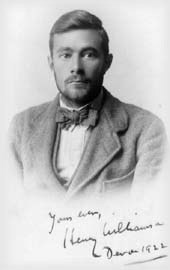
The ex-officer must have presented an extraordinary sight to the villagers of the quiet North Devon village which had changed little in the past 100 years. Dressed so casually that he often wore no shoes, he slept out in the summer, swam naked, threw apples at passers-by, and wrote day and night. His ‘strangeness’ was compounded by the friends that he had, particularly his equally wild companion who shared his cottage at first, called ‘Julian Warbeck’ in his novels, and also the succession of young ladies with whom he had intense relationships. He tried to join the activities of the established social circle, joining the tennis and sailing clubs, but they could not understand his eccentric behaviour and wild manner and tended to ostracise him, whilst the village people did not understand him either. He was regarded with suspicion, considered an outsider and a very strange young man, being called ‘funny’ or even ‘mazed’ by the locals.
Yet his portrayal of their village, their conversations, their customs, parish meetings and country sports were deadly accurate, wickedly funny, but sympathetic; and captured just in time. The Village Book, and its companion volume The Labouring Life, portray a life long gone but for which there is today a great nostalgia. (These titles were revised and reprinted in 1945 as Tales of, and Life in, a Devon Village.)
Sustained by sporadic newspaper articles and stories in magazines, payment for which seems to have been quite generous, fourteen guineas being a frequent sum, further volumes of his tetralogy The Flax of Dream were published, the second volume, Dandelion Days, and also the collection of nature essays The Lone Swallows, in 1922. Before Henry had left London he had belonged to a club for young writers called The Tomorrow Club, where he had met several established writers who came to give talks to the aspiring literati including John Galsworthy and Walter de la Mare, who had very generously given Henry permission to dedicate one of his stories to him. Henry also met the great author’s son, Richard de la Mare, with whom he became friends and who was to be Henry’s best man in due course. The Peregrine's Saga, another collection of short stories was published in 1923, while the third volume of The Flax of Dream, The Dream of Fair Women, appeared in 1924.
Simultaneously published in the United States of America by Dutton’s Pub. Co. these books were attracting much attention from reviewers and critics, as shown by his book of cuttings. The young author was already making a name for himself.
